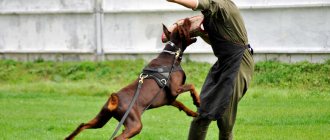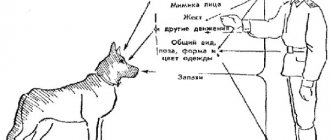How to teach a dog to distinguish between friends and strangers. How to teach a dog the “stranger” command
Of course, decorative dogs are not bought to protect the house, but for the soul.
But why not combine business with pleasure and use the innate abilities of dogs given to them, regardless of the size and characteristics of the breed? Of course, a toy terrier may not be able to detain a burglar, but with their loud barking they are able to raise the alarm and even scare off an intruder who does not count on the presence of a dog in the house. A dog distinguishes its own from strangers by many signs that often go unnoticed by us. It analyzes smells, voices, and sounds made by people when they move and touch doors. Moreover, a four-legged friend can sense the approach of familiar people from afar and will rarely bark at them. We are talking not only about family members, but also about friends who are often in the house. Larger dogs are trained not only to signal when a stranger tries to open the door, but also to resist. The role of small animals is to serve as living alarms.
Teaching Methodology
All dogs have a wary reaction to the appearance of strangers at the door. Usually they start barking and squealing loudly. In this case, the owner must approve the animal’s action with the command “Guard,” repeating it several times and accompanying it with the word “Okay” and stroking.
It is very important to develop a calm, even and good-natured attitude towards the dog. Once frightened, she may react to strangers with fear or act like a “clueless.”
If the dog does not react in any way to a bell or knock on the door, you should bring it to the door and encourage it to bark with the “Voice” command - provided that the dog is already familiar with it. It is advisable to regularly train this skill for some time with partners - guests who are unfamiliar to the dog.
After teaching your dog to respond correctly to strangers, you should teach him to stop barking in the presence of his owner. To do this, she needs to be calmed down, even to the point of prohibiting barking. In this case, you can use unconditional reinforcement - a tug on the leash or collar. After the dog is silent, hold it while allowing the person entering the house. If the dog continues to react too emotionally, simply take him to another room. Punishments, especially painful ones, for an evil attitude towards the newcomer are unacceptable.
Does your pet, the future protector of the family, see no difference between strangers and owners? Does he jump equally joyfully when he sees both the owner and the electrician Ivan Petrovich on the threshold? Disorder. How to make a dog angry at strangers will be discussed in this article.
How to raise a defender
The difference between the commands “alien” and “fas”
When starting training, you need to clearly distinguish between the commands “alien” and “fas”. The owner's cry of "stranger" means a danger signal. The dog should be alert and react by growling or barking at a stranger or stray dog, without trying to attack first. The animal protects itself and its owner.
The "fas" command is the next level. Hearing her, the animal itself rushes at strangers and bites them. This command is taught to pets of service and guard breeds, and after they have completed the OKD (basic training course). The pet must first learn to clearly follow the commands “fu”, “near”, “come to me”, “lie down”, “sit”.
In our case, the dog must become angry at strangers, that is, learn to carry out the “stranger” command.
Teaching Methodology
It should be remembered that a dog, especially a service dog, poses a certain danger to others. Therefore, her training should be approached with all responsibility. The dog should show aggression if:
- on the street the owner is threatened by an inappropriate stranger;
- there is a threat of attack by a stray animal;
- Intruders are trying to break into a house or car.
Team training starts at home. You need to ask someone to knock on the door. The animal’s natural reaction will be to bark, and the owner should clearly say “stranger” while praising the dog. To consolidate the result, you need to do several repetitions of these actions.
The next stage is outdoor activities. The helper approaches the dog and the owner with a stick in his hand and begins to behave aggressively: screaming, waving the stick. The owner should clearly say “Stranger!” and push the stranger away. The dog will most likely growl or bark and should be rewarded, praised or petted. It is not advisable to give treats so as not to distract from the learning process. Over time, a connection will be established in the pet's mind between the command and the need to bark in such a situation.
But another reaction of the animal is also possible. The dog may become frightened by an aggressive stranger, start whining, fall on its back, or try to run away. Then the assistant should quietly come up from behind and pinch her by the fold of skin near her hind paw. Painful sensations cause a response, the dog becomes angry. When using this method, the animal must be muzzled.
When training an animal, you need to remember the basic rules:
- ZKS (protective guard service) classes should be conducted in specially designated places, on sites or, if there are none, somewhere outside the city;
- dogs from the Molosser group (Bullmastiff, Dogue de Bordeaux, Great Dane, Rottweiler, etc.) mature late (by 2-3 years) and it is worth starting ZKS classes with them already in adulthood, so as not to cause harm to the fragile psyche and make the dog overly aggressive or uncontrollable;
- You cannot involve acquaintances, and especially family members, as a “villain”; the pet may begin to perceive them as enemies in everyday life;
- you need to start classes only when you are confident in the unquestioning obedience of the animal in order to stop it if necessary, for example, when trying to attack an imaginary attacker;
- the learning process on the street should be made safe for the assistant and passers-by; the pet should be kept firmly on a leash.
The command "FAS!" is often necessary to protect the owner from ill-wishers, stray dogs or uninvited guests.
It is possible to teach a dog a command, although to fully practice it you will need the help of a person unfamiliar to your pet. How to make this process productive without harm to your pet in our article.
Possible mistakes
Mistakes always lead to undesirable and unexpected results - improper training will lead to excessive aggression, and superimposing malice on natural cowardice can cost the life of the owner or those around him.
- Protection training begins after six months of age (the later the better). Until this moment, the pet must live and grow exclusively in friendly conditions.
- Only strangers are recruited as assistants. By the way, the assistant in each lesson should be different, otherwise an active defensive reaction will be developed exclusively against a specific person.
- During work, the animal is not allowed off the leash and is not allowed to attack an ill-wisher.
- Training is carried out only after mastering the basic disciplinary commands: “Sit”, “Come to me”, “Fu”, “Next”, etc.
- Punishment cannot be applied in the absence of correct actions, otherwise the animal will be even more afraid.
- Also, you should not punish your pet if he continues to show good nature to the first person he meets. At such moments, the puppy is distracted, and people are forbidden to make any contact with the baby.
With the right approach, the “Alien” command can be useful in everyday life: it will not give the opportunity to steal an animal, and a growl can scare an intruder, which will ultimately protect the owner from attack.
Methods of training
Training to show aggression on command is carried out for the following cases:
- If a drunk or inappropriate stranger accosts the owner on the street;
- If uninvited guests try to enter the house.
Even a small dog can confuse an annoying interlocutor with its snow-white teeth and make noise when trying to rob a car or apartment.
Training in anger begins with encouraging any manifestation of guarding qualities: when barking at noise outside the door, the pet is heatedly praised, egged on with the command “stranger!” When the dog actively barks at any knock on the door and starts barking at the word “stranger!”, then you can move on to teaching aggressive behavior on the street.
To fully react to a stranger on the street, you need to ask a man unfamiliar to the dog to extend his hand to the owner. The owner’s task is to push away the “intruder” as seriously as possible, saying “stranger!” If your pet barks or tries to bite, you should immediately praise the dog.
Important: when practicing the command “Fas!” no treat is given, the best reward is the escape of the “criminal”.
Various techniques
There are several methods for teaching your pet the front command yourself.
All of them are trained on a leash.
Method 1
- The dog stands next to the owner on a soft collar or harness.
- The assistant comes out of hiding and begins to sneak up on the animal, bending down and arousing suspicion with his behavior.
- The owner encourages the dog with the command “stranger”.
- Having approached five steps, the assistant turns around and runs away, the dog tries to grab him, the command “Face!” is given.
This technique is well suited for insecure, timid animals. There is no direct interaction with the enemy.
Method 2
- The pet is on a leash, a favorite toy or bone lies nearby, the assistant walks by, pretending to try to grab the thing.
- The dog begins to break from the leash, trying to bite the intruder, pronouncing “fas!”
The method works well with angry, suspicious dogs.
Method 3
- The dog is tied to a post or tree, the owner stands nearby.
- The assistant passes by several times, teasing the dog with a rag and running away, the owner says “stranger.”
- When the pet gets angry, the assistant approaches the owner and pretends that he wants to attack him.
- The owner shouts: “Face!”, pushes the enemy away; if the dog tries to bite, the rag is given to it, and the assistant “runs for his life.”
Method 4
- In the courtyard of a private house, you can stage an attempt to break in by robbers.
- To do this, the assistant makes suspicious noises and rustles behind the fence, tries to look into the yard, opens the gate and sticks his jacket through it.
- Attempts by a pet to grab a thing, barking at a stranger are encouraged by the word “stranger!”
- This lasts no more than five minutes, then the dog is put on a leash, the owner takes it out the gate, and at the command “Face!” begins to pursue the assistant.
You can let the dog catch up with the person and grab the rag or jacket that he leaves behind.
Where to begin
First of all, think about whether your four-legged dog will be able to learn the “face” command. If you have a gentle and soft pet that does not hold any pressure and, if something happens, can get scared and squeeze, it is unlikely that he will be able to really protect you in a moment of danger.
The “Face” command should be taught to dogs with a strong, stable psyche.
Find an open area with a tree or pole to which you can tie your pet. Under no circumstances should the dog be wearing a collar, as during the training process the animal will pull and tear strongly. To keep your pet healthy, wear a harness while training.
Stopping aggression
Before teaching an animal to attack people, you should completely subjugate it to your will. In the process of fighting with another dog or person, the dog gets so carried away and forgets about everything that it is impossible to calm him down.
It is very difficult to switch dogs that have never participated in fights before, temperamental and choleric animals to carry out prohibiting commands. Therefore, in the German Shepherd courage test, not only the strength of the grip and the lightning-fast reaction to a threat are taken into account, but also the ability to let go of the criminal’s hand at the owner’s command.
" It is the same. However, experts know that the first command is an intermediate link between preparing and teaching the dog to attack and actively defend. So, let's see how to teach a dog a stranger's command.
In fact, upon hearing the command “stranger,” the dog should under no circumstances rush at the newcomer. It is enough that he becomes wary, growls or starts barking loudly. That is, this task does not encourage the dog to take active action, but is only a signal to show alertness - the pet must be prepared for any outcome.
The dog should master this skill no earlier than he has mastered a set of basic commands - " ", " ", " ", etc. Moreover, he can begin training if he completes the remaining tasks the first time, unquestioningly obeying. Serious training should take place no earlier than six months, since the early development of viciousness or aggressive behavior can cause the dog to become nervous and intimidated.
Features of training
- Before you start training your pet as a serious command, you need to realize whether you are ready to take on such responsibility, because if you make mistakes in training, it will be difficult to avoid irreversible consequences.
- To avoid the risk of aggression in an animal towards people or animals in everyday life, it is recommended to periodically visit a dog handler so that he, seeing the shortcomings in reality, can help you correct them. If the dog trainer sees that you are training your pet incorrectly, he will direct you in the right direction.
- Not all dogs are capable of learning the “face” command. Training depends not only on the breed of the animal, but also on its psyche and character. You cannot teach the “face” command to a dog with a weak nervous system (such dogs are cowardly and overly emotional). It is strictly recommended to train an aggressive animal with the help of an experienced dog handler, since you yourself can only aggravate the situation.
- Before learning the “Face” command, the dog must know the basics of the general training course. The main thing is that the dog respects the owner and does not violate boundaries, and also clearly understands the meaning of the commands “fu” and “no”.
- It is impossible to learn the "fas" command alone. You will need an assistant in a specialized protective suit.
- In addition to training, do physical training with your pet. Build strength and endurance in your animal, develop muscles. At a minimum, you should take your dog for long, active walks. You can also give your pet trotting and swimming exercises to improve physical fitness.
It is important not to overdo it and adequately dose the load for the animal. Of course, the dog must be healthy.
Is it necessary to master the “alien” command?
This command is not always required, and the owner must first weigh everything: whether the pet needs to develop aggression, and whether the owner himself has enough strength and influence to control its manifestations.
Incorrect training, especially when it comes to dogs with an unbalanced psyche, can lead to the animal growing up angry and uncontrollable. Experienced breeders and dog handlers note a number of features:
- Large service dogs, even without additional training, rush to protect their owner if a dangerous situation arises, especially if their relationship is based on friendship and trust.
- Owners of dogs of decorative breeds will not receive any benefit from training such a command. It is unlikely that a tiny Chihuahua or lapdog will cause fear in anyone, even if they bark furiously.
- If improperly trained, a dog can show hostility towards its owner or family members; naturally, such an animal is very dangerous.
Among the positive aspects, it can be noted that the pet will not fawn and trust everyone passing by or entering its territory.
Is it worth learning
Before making a decision to teach or not to teach, you need to clearly determine for yourself whether it is really necessary to develop aggression in your pet and whether it can be subsequently controlled.
With improperly structured training, especially with dogs of an unbalanced excitable type, it is very easy to disrupt the psyche and instead of an obedient and friendly dog, you can “raise” an angry and uncontrollable beast.
This is how it was noticed:
- Dogs of large, service breeds undergoing training, even without targeted training, will protect their owner in dangerous situations, especially if friendly relationships have been established between them.
- On the other hand, small animals or representatives of decorative breeds, although they easily learn to show an active defensive reaction, but what is the point of this? Its non-intimidating appearance and small dimensions are unlikely to frighten anyone much.
- Problems are possible when inept training leads to hostility towards the owner or family members and such an animal literally becomes a killing machine.
There are also positive aspects: the puppy, and subsequently the adult animal, ceases to fawn and trust all passers-by or strangers appearing on its territory.
Training scheme
It is worth immediately taking into account that it will not be possible to train a pet alone - you will need helpers, and not close ones or relatives. Ideally, such training is best done with the assistance of an experienced instructor. A professional will be able to immediately assess whether the dog is suitable for learning such skills.
Another important nuance - if the owners know from the first days that their pet will master such serious commands, then from the first days it is recommended to protect it from contact with strangers. That is, it is forbidden for strangers to play and stroke the baby. People coming into the house are warned not to show increased attention to the pet. Already in this case, you can pull the puppy by the leash and say the command “stranger”.
When the dog has grown up, become stronger, and mastered basic skills, you can begin specific training - distrust, anger towards strangers. It is necessary to find several assistants and provide them with a special protective kit. Like other training, training is carried out in a quiet, familiar place, without any distractions. This process includes the following steps:
- The dog must be restrained using a short leash (see).
- The assistant must approach the person with the dog and show aggression towards them - swing his hand or stick, but at the same time he must show with all his appearance that he is afraid of the dog.
- Without letting the dog off the leash, the person gives the command “stranger”, using intonation that warns of the existing threat.
- Any hostile reaction - the dog growls, barks, grins, tries to attack a stranger - is encouraged, but the command must first be repeated.
Then you need to take a break so that the dog calms down, rests and comes to his senses, and then repeat the procedure. It is not recommended to overload the dog - two or three approaches per session are enough.
Stages of training
Puppy training
You can start laying the foundation for a puppy from the age of 1.5-2 months. Of course, there can be no talk of any manifestation of aggression, much less an attack.
At this age, it is necessary to work with the puppy to strengthen the prey instinct. To do this, you need to take a toy and act out your pet.
Play a little every day, ending at the most interesting moment of the game. The dog must chase and pull the toy.
It is important to let the dog win in the fight so that he does not lose interest in the activity.
Offer your animal a variety of toys, including all sorts of rags, grips, and whatever your imagination allows.
The pet's grip should be strong enough, that is, he should hold the toy tightly and not intercept it while tugging. To strengthen your grip, make your dog feel more confident by allowing him to win more, and also develop an interest in the game.
It is important to teach the animal the skills of “give” and “fu” - the dog must unquestioningly follow these commands. By the time you reach one year, you can move on to the next stage of training, which involves training an adult animal.
Training an adult dog
Let the dog get acquainted with the territory of the lesson, then take the animal on a leash and tie it to a tree. Make sure your pet is not confused or distracted by anything.
Stand to the side of the animal so that its body is near your left leg. The dog must sit or stand.
Call the assistant - the person involved. Start saying “stranger” in a provocative tone. Even if the dog doesn’t yet know the meaning of the word, this is necessary to create an association with the “fas” command in the future. The word “stranger” will be a signal for the dog to follow the command “front”.
Ask your assistant to move in strange, hesitant movements. The person involved should also take a rag and wave it, moving towards the pet. A tight leash will further provoke the dog to show aggression. If you feel that the dog is tense enough, and the helper has approached close enough, make a sharp lunge forward and give the command “front”. The dog should rush towards the person and tear the rag or protective sleeve. Praise your dog verbally. After a few seconds, command “fu” and take the dog back to the tree. Repeat this several times.
Untie your dog from the tree, but do not let him off the leash. The animal should be near your left leg. Ask your assistant to move 3-5 meters away from you, also moving in a strange way. As soon as the dog tenses up, make a sharp lunge forward, giving the command “front”. The dog must run to the person involved and grab him. After a few seconds, give the command “fu” and take the animal away. Repeat this several times.
Ask the person involved to run away from the dog, and after placing the dog at your left leg, at the moment of tension, lunge forward and give the command “front”. The dog must catch up with the person involved and grab him, after which you come up and give the command “fu”.
Once you are convinced that the dog clearly releases the helper on the “fu” command, you can work without a leash. Train in different environments and under unforeseen circumstances, bringing the situation as close as possible to the real one. Only then will the pet really be able to protect you in the event of a real danger.
What if the dog doesn't want to show aggression?
Quite often, owners are faced with the fact that their pet does not show aggression towards a stranger. But in this case, you should not immediately retreat and use more active methods:
- the assistant does not wave his hands, but tries to attack the owner;
- he tries to take away from the owner a treat intended for the pet;
- “attacking”, the helper lightly hits the dog, not to cause bodily harm, but to provoke aggression.
Dog handlers warn that excessive use of physical violence can have the opposite effect - the dog will become not angry, but cowardly. The assistant is required to have an attentive and careful approach - he must observe the dog’s behavior and, if necessary, stop training. This is done so that the person does not suppress the dog - in this “fight” the animal must always win!
Encouragement is important - for the expected reaction the dog is petted, words of praise are spoken, and a treat is given. But it is advisable not to overdo it with the last point. You can also reinforce the result when walking - the command is pronounced if the pet begins to growl or grin at a passerby. During walks, you can also provoke the dog - ask the assistant to quietly approach the dog when he is not expecting it, and pat him, for example, on the rump. The owner gives the command at this moment.
With the right approach, after some time, the dog develops the necessary reaction - he shows distrust of strangers and does not feel fear when they swing at him.
Teaching your pet the “stranger” command is an event that requires a serious approach. If the owner is not ready for consistent work while observing a number of rules, then there is no point in starting. After all, it is not difficult to harm a puppy’s psyche, but it is not possible to correct the situation in certain situations. No confidence in your own abilities? Then it is better to contact an experienced dog handler.
The command "FAS!" is often necessary to protect the owner from ill-wishers, stray dogs or uninvited guests.
It is possible to teach a dog a command, although to fully practice it you will need the help of a person unfamiliar to your pet. How to make this process productive without harm to your pet in our article.
Before teaching an animal to attack people, you should completely subjugate it to your will. In the process of fighting with another dog or person, the dog gets so carried away and forgets about everything that it is impossible to calm him down.
It is very difficult to switch dogs that have never participated in fights before, temperamental and choleric animals to carry out prohibiting commands. Therefore, in the German Shepherd courage test, not only the strength of the grip and the lightning-fast reaction to a threat are taken into account, but also the ability to let go of the criminal’s hand at the owner’s command.
People who have little knowledge of dog training may think that “alien” and “fas” are one and the same thing. However, experts know that the first command is an intermediate link between preparing and teaching the dog to attack and actively defend. So, let's see how to teach a dog a stranger's command.
If the dog is not aggressive
There are animals that do not show any malice towards a stranger. In such situations, it is necessary to compromise and bring in heavy artillery. Here are some ways:
- the assistant “attacks” the owner;
- the assistant imitates taking away food from the owner, which is intended for the dog;
- During the “attack” the ill-wisher inflicts light blows on the animal.
It is important not to overdo it with physical violence: the animal develops malice, not cowardice. Therefore, blows should not be strong or cause severe pain - they should only inflame aggression and active defense.
It is for this reason that the assistant must be experienced and carefully monitor the student’s behavior, and if necessary, retreat in time so as not to overwhelm the dog. The dog must always remain a “winner”!
Naturally, at the moment of manifestation of any kind of wariness or malice, they pronounce the command “Stranger” and reward the animal in a convenient way (affection, encouraging words, treats). It is advisable not to abuse taste rewards.
After some time, the animal develops an active defense, it becomes distrustful of any stranger and is no longer afraid of blows.
What is meant by the command “Alien”
Strictly speaking, “Stranger” is not a command, but a way to set the tone of behavior; the opposite situation is when you say “Friends” to your dog when friends come to visit you. Having heard the word stranger, the dog should not rush to attack (Face) or defend the entrusted object (Guard). The command is foreign to the dog; it is a signal that there is a suspicious person in front of him, who could hypothetically cause harm.
When executing a command, showing aggression is encouraged - growling, grinning, barking, bristling, taking a position for attack. And at this stage, the trainer is faced with the first nuance - each dog shows aggression in its own way. German shepherds make their position clear by barking, growling, and posturing, while Caucasian dogs will not raise an eyebrow, but will silently prepare to attack. Your task is to observe your pet from early childhood, in games, he will show his natural skills and habits.
Note! The “Alien” command is not mandatory, but is convenient in everyday life. Most often, a fight or attack can be avoided if the pet can visually demonstrate aggression.
When to start learning the Alien command
Before teaching a dog a stranger’s command, you need to learn a number of rules:
- ZKS is a set of commands for an adult dog or teenager, but not for a puppy. By developing aggression in a puppy not “for fun”, you risk the safety of your family and the people around you.
- The command is difficult to master and it is highly not recommended to practice it only on your own if you do not have the appropriate canine experience.
- Before training, it is recommended to consult with a dog trainer. A professional will understand the dog’s psychotype and degree of excitability by observing it on the site and will give recommendations for training.
- Do not teach your dog the “Stranger” command at home, and do not involve family members.
- Do not approve of a dog barking under the door, a loud growl at most. Contrary to popular belief, you will not reinforce the “Alien” command, but a “bad habit” that is really hard to break.
- Only a person unfamiliar to the dog, dressed in a special suit and hiding his face with a mask, can act as a bandit.
- Before starting the ZKS course, the dog must undergo a general training course (general training course), unquestioningly follow the commands Fu, Come to me, Sit, Lie, Near, Place.
Note! Temperamental dogs have a hard time containing their emotions. It is recommended to train such pets to bark - the dog is at a safe distance from the enemy, growls and barks, but does not attack without a command from Fas, and stops aggressive actions on the orders of the owner.
If you are planning to take a ZKS course, prepare your dog in advance:
- Age up to 10 months - the loving ball licks and rejoices at everyone, which means you should limit your pet’s communication to a narrow circle, reduce visits from guests and strangers.
Important! When asked by a stranger or even a child: “Can I pet you?”, answer with a categorical refusal. A dog must separate its own from those of others.
- From 12 to 18 months, we carefully observe the pet’s games, noticing its strengths and weaknesses. It's time to train your dog to work in unusual conditions - clapping, screaming, traffic noise, strangers, etc.
- And finally, from 1.5 years old, we undergo a consultation with a dog handler, receive recommendations and teach the dog protection.
Teaching a dog the “Alien” command
If your pet has not yet reached 1.5 years of age, do not require decisive action. Stop attempts to “kiss” the first person you meet, sit the dog at your feet, calm him down, quietly and confidently say “Stranger!” Your task at this stage is to teach the puppy to be alert.
It is optimal to conduct training with a trainer (canine handler). By spending time on training, you avoid unwanted consequences, possible fears or the development of uncontrollable aggression. If you don’t have the opportunity to work with a trainer, teach the dog yourself.
Are you sure that your pet will rush to defense? Great, negotiate with the potential “bandit” and go for a walk. Lead the dog on a leash, encourage and fear at the right moment. The bandit navigates the situation; if the pet is not confused, he swings his arms, screams, threatens. You just give the command “Alien!” and keep a leash, especially if the pet is large and can cause harm.
Important! Many dogs, sensing danger, lower their heads and back away. Be careful, this is not fear, but preparation for the jump.
The situation is more complicated; if the pet is tolerant or phlegmatic by nature, you will have to be cunning. It is difficult to provoke a calm dog, but it is possible:
- “Catch” your pet at an emotional moment and clearly command “Stranger!”, no matter who is in front of you - a person, a bird or another animal - the main thing is to consolidate the voice command.
- Dogs don’t like the smell of alcohol - the bandit “with amber” will at least outrage the pet. Your job is to observe, and if the pet is tense, quietly and confidently say “Stranger!”
- Well, the last option is suitable for a brave bandit. During a normal walk, the scoundrel sneaks up behind the dog and grabs the skin and fur in the croup area. A slight tension in this area irritates and provokes any dog to defend itself. Team "Alien!" and the act of attack must be synchronous. Be careful, it takes a few seconds to turn around and grab the attacker with your teeth.
Note! All training should end with the victory of the pet and the hasty escape of the attacker.
Other training methods
There are alternative methods for teaching a dog the “Alien” command:
- If during a walk the animal independently shows hostility towards a person passing by, then at the same moment the words of the command are pronounced.
- Again, during the walking process, they use the method of surprise, which helps even the most timid pet to awaken the beginnings of protective behavior. To do this, the assistant sneaks up behind the dog and lightly pinches its croup or belly, at the same moment the trainer says “Stranger.” Important: the student must be muzzled, while carefully monitoring the pet’s behavior - this method may not always lead to the desired result and instead of malice, caution will be practiced, and the dog will look around in fear of getting another blow.
How to teach a dog to growl?
Perhaps everyone knows that a growling dog is not at all friendly. Growling is not only a kind of warning, but also to some extent a manifestation of self-defense and anxiety.
A growling dog does not evoke the most positive feelings, so many owners wonder how to teach a dog to growl on command. Such a growl is not dangerous to others, but it looks quite convincing. In this way, if necessary, you can convince others that the dog is quite aggressive and can stand up for itself and its owner.
Growling training
It is better to start teaching your dog to growl on command at an early age, but after teaching the “Voice” command.
To do this, give the command “Voice”, then slightly squeeze the mouth with your hand. The puppy's barking should turn to a growl: at this time you should give the dog a treat, and then repeat the exercise several more times.
You can replace the “Voice” command with something else - for example, “Roar”.
You can also teach a puppy to growl using the principle of imitation. You should demonstrate to the dog that he needs him. Puppies, as a rule, love such training methods - they perceive them as a game.
In general, the main reason why a dog growls is a certain amount of anger and aggression. If there is a desire not only to teach a dog to growl, but to react in this way to “strangers,” the training should take place according to a different scheme, and the dog should be muzzled.
A “stranger” to the dog should lure the dog with a piece of treat, and at the moment when it reaches for it, lightly flick it on the nose. This will cause some aggression, the dog will try to bark, but the muzzle will not allow it to do this - it will result in a growl. At this time, the owner must pronounce the command “Growl”
With a little effort, the dog will not only vocalize, but also growl on command. Execution of such commands is a sign of a well-mannered, intelligent dog; Moreover, such dog skills can be useful to the owner in case of self-defense.
Useful materials:
- How to teach a dog to fetch? Training ProcedureTeaching a dog to play with a stick is not very difficult, since most of them love...
- How to teach a puppy the “No” command What do the “Fu” and “No” commands mean for dogs and are they different from each other? Some...
- How to teach a dog commands How to quickly teach a dog to carry out basic commands at homeTraining a dog requires from the owner not only patience and...
- A dog for an apartment and a child without odor A dog for a child and an apartment without smell and a good character There are many options if you…











